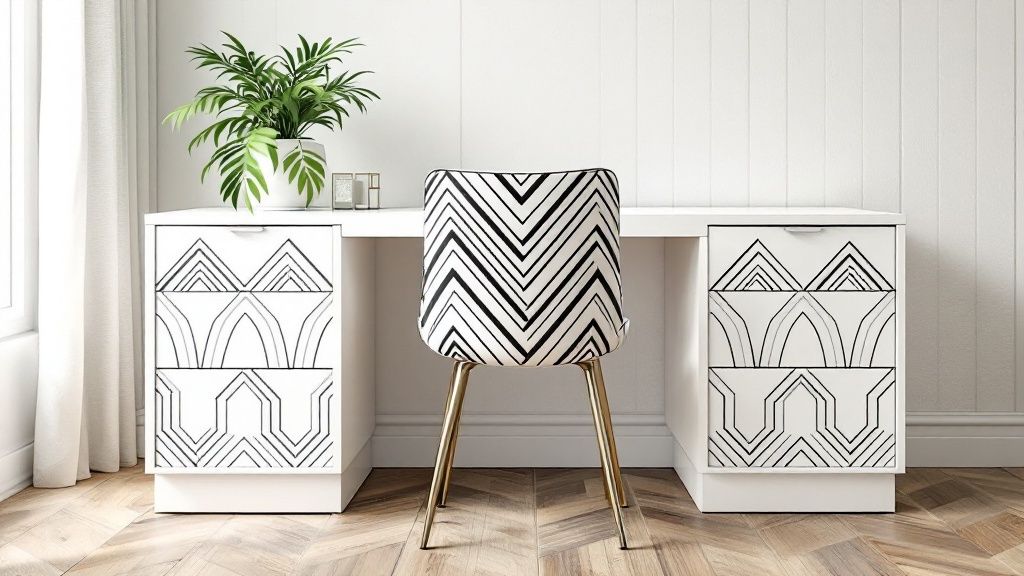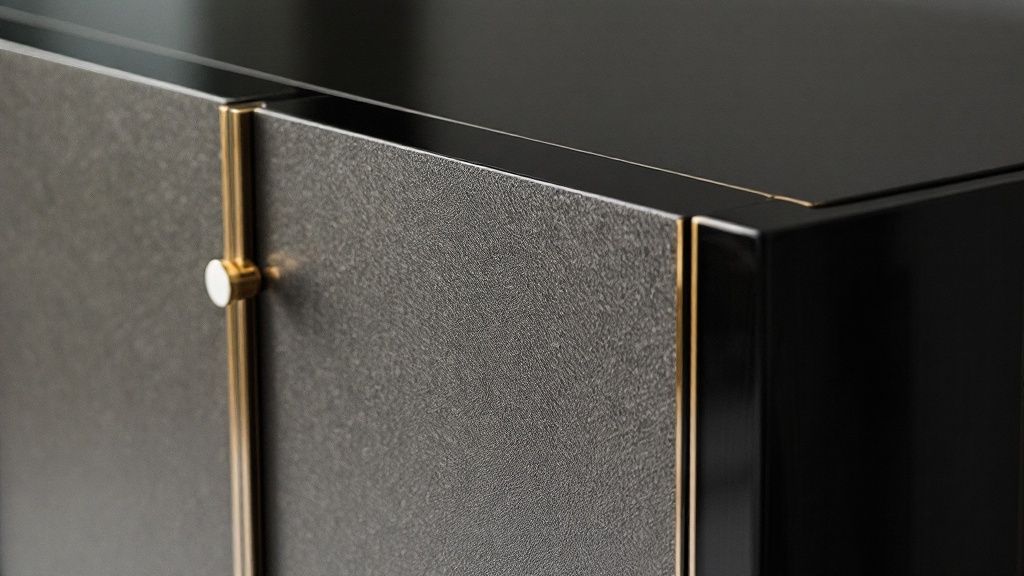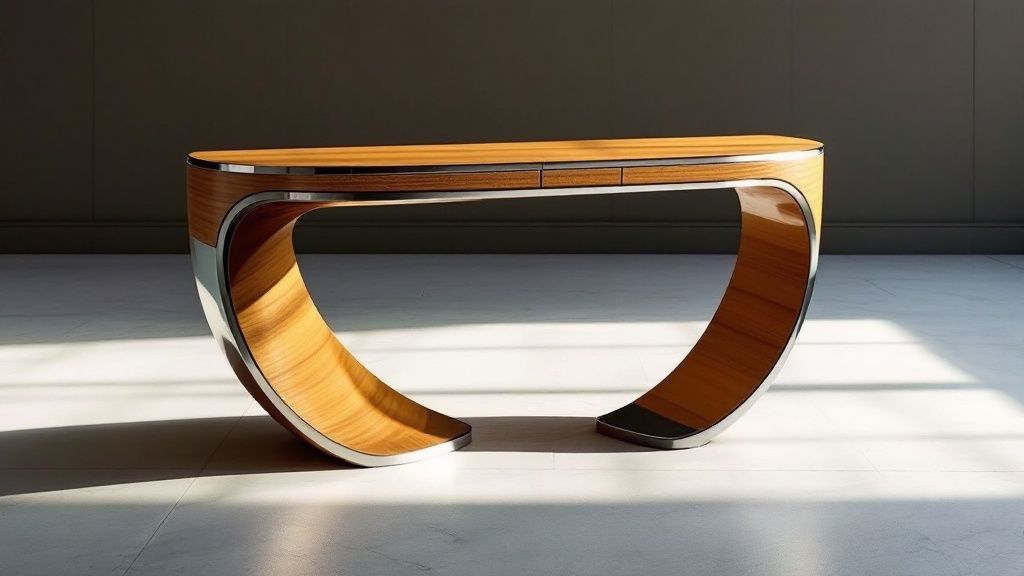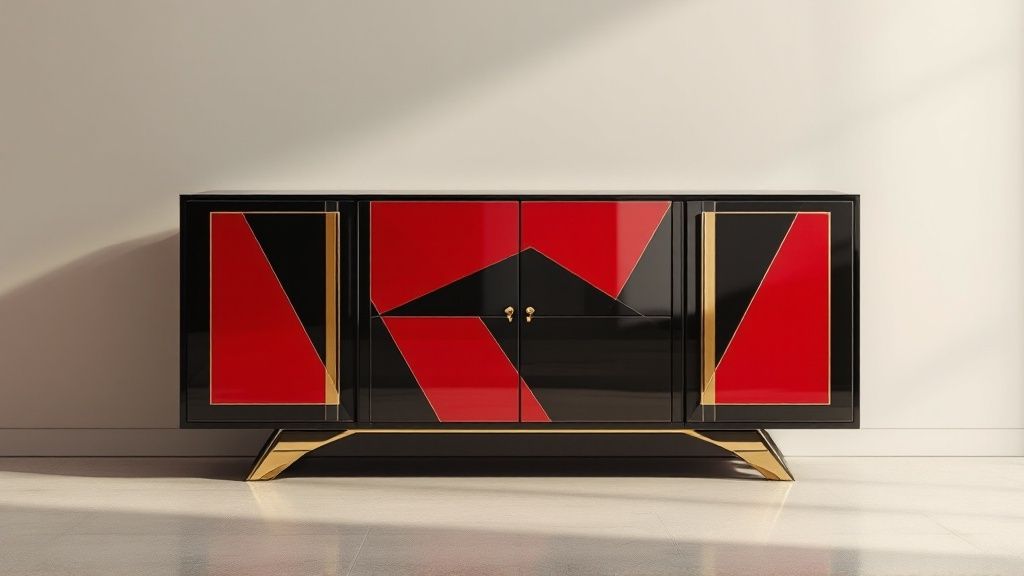Discover Furniture Styles by Decade | Timeless Design Trends
05.28.25

This guide reveals seven key art deco furniture characteristics to help you identify and appreciate this iconic style. Whether you’re a homeowner, interior designer, or simply admire beautiful furniture, recognizing these elements is crucial for understanding what makes Art Deco so distinctive. From geometric shapes to luxurious materials and machine age influences, learn to spot authentic Art Deco pieces. This knowledge empowers you to make informed decisions when selecting furniture that adds sophistication and value to your space.
One of the most defining art deco furniture characteristics is the prominent use of geometric shapes and bold, linear elements. This stylistic choice creates the distinctive aesthetic that sets Art Deco apart. From symmetrical patterns and stepped designs to dynamic zigzags and chevrons, these geometric motifs emerged in the 1920s as a direct response to the flowing, organic curves of the preceding Art Nouveau period. This emphasis on geometry reflected the era’s burgeoning fascination with modernism, machinery, and the idea of progress. Specifically, features like zigzag patterns, chevron designs, stepped forms, sunburst motifs, symmetrical arrangements, and bold outlines all contribute to the signature Art Deco look.

This focus on geometric forms creates a strong visual impact, giving Art Deco furniture a timeless appeal that remains instantly recognizable even today. It’s a style that seamlessly integrates into contemporary settings, adding a touch of vintage glamour. The pros of incorporating geometrically-driven Art Deco furniture are clear: it offers a strong visual impact and a timeless geometric appeal that’s instantly recognizable. It also works surprisingly well in contemporary settings, adding a layer of sophistication. However, there are some potential drawbacks. In some spaces, the style can appear cold or impersonal. The bold patterns can also overwhelm smaller rooms, and the strong geometry may clash with more organic or free-flowing design elements.
Examples of successful implementation of this principle can be seen in the stepped silhouette of furniture inspired by the iconic Chrysler Building, Jacques-Émile Ruhlmann’s ‘Concordia’ desk with its distinctive geometric marquetry, and Donald Deskey’s streamlined furniture designs for Radio City Music Hall. These pieces masterfully showcase the power and elegance of geometric design. Learn more about Geometric Shapes and Bold Lines
When incorporating Art Deco furniture into your space, consider these tips: balance the geometric furniture with softer textiles like plush rugs and velvet cushions to add warmth. Start with statement pieces like a striking cabinet or armchair, rather than filling the entire room with Art Deco designs. You can also incorporate mirrors with geometric frames to enhance the effect and amplify the sense of space and light. Pioneering designers such as Jacques-Émile Ruhlmann, Donald Deskey, Paul Follot, Émile-Jacques Ruhlmann, and the Sue et Mare design firm helped popularize this defining characteristic of Art Deco furniture. Their work continues to inspire and influence designers today.
One of the defining art deco furniture characteristics is the prominent use of luxurious and exotic materials. This design movement, flourishing in the 1920s and 1930s, moved away from the more traditional wood furniture of earlier periods and embraced a new era of opulence and global influence. Art Deco furniture makers incorporated rare wood veneers, inlays, and a variety of other materials to create visually striking pieces with contrasting textures, reflecting the international and colonial connections of the time. This emphasis on lavish materials instantly conveyed a sense of luxury and sophistication, setting Art Deco apart from its predecessors.

Exotic wood veneers such as zebrawood, macassar ebony, and amboyna burl were highly sought after for their rich colors and dramatic grain patterns. Shagreen (sharkskin or ray skin), often dyed in vibrant hues, added a unique textural dimension. Mother-of-pearl inlays provided shimmering accents, while ivory (now largely restricted due to conservation efforts) and chrome detailing added further touches of elegance. Lacquered surfaces, often in black or bold colors, provided a sleek, polished finish and helped protect the underlying materials. The combination of these diverse materials resulted in furniture pieces that were not only beautiful but also highly durable.
Examples of this masterful use of materials can be seen in Émile-Jacques Ruhlmann’s ‘Tibattant’ cabinet, featuring richly figured macassar ebony veneer, and the lacquered furniture pieces by Jean Dunand. René Lalique, renowned for his glass artistry, also incorporated glass elements into his furniture designs.
While the use of such high-quality and rare materials creates an immediate sense of luxury and provides unique textures and finishes that age beautifully, there are also drawbacks to consider. Sourcing authentic materials can be expensive, and some, like ivory and certain exotic woods, are now restricted due to ethical and environmental concerns. Maintaining these pieces also requires special care, with lacquered surfaces needing specialized polishes to preserve their shine. Learn more about Luxurious and Exotic Materials
For those seeking the Art Deco aesthetic without compromising on ethics or budget, there are viable alternatives. Synthetic shagreen and sustainable exotic wood veneers offer a responsible way to achieve a similar look and feel. When incorporating Art Deco style into your home, consider mixing one statement piece made with exotic materials with simpler, more readily available furniture to create a balanced and impactful design. This approach allows you to appreciate the artistry of Art Deco without overspending or contributing to unsustainable practices. For homeowners seeking a touch of vintage glamor, interior designers creating unique spaces, or collectors searching for investment pieces, understanding the role of materials in Art Deco design is essential.
Streamlining is a defining characteristic of Art Deco furniture, deeply rooted in the era’s fascination with technological advancements, particularly in transportation. Inspired by the aerodynamic forms of airplanes, automobiles, and ocean liners, this aesthetic emphasizes clean, flowing silhouettes that evoke a sense of speed and forward momentum. Art Deco furniture designers embraced simplified forms, often incorporating curved corners and swept-back angles, while eschewing excessive ornamentation typical of earlier periods. This resulted in pieces that maintained an elegant and sophisticated appearance while celebrating the dynamism of the modern age. This is a key art deco furniture characteristic because it distinguishes the style from others, giving it a distinct modern feel.

Key features of streamlined Art Deco furniture include aerodynamic curves, swept-back angles, rounded corners, a horizontal emphasis, stepped profiles, and often tapered legs. These features contribute to a sense of movement and modernity, making streamlined pieces ideal for those seeking a contemporary feel. The horizontal lines and streamlined profiles also visually elongate spaces, making them a clever choice for smaller rooms. Furthermore, the streamlined aesthetic transitions seamlessly between traditional and modern interiors, allowing for versatile integration into various design schemes. The often less bulky forms contribute to a feeling of lightness and airiness in a room.
Examples of iconic streamlined Art Deco furniture include Norman Bel Geddes’ innovative desk designs, which captured the spirit of the machine age, Paul Frankl’s iconic ‘Skyscraper’ furniture series, a testament to the era’s architectural aspirations, and Wolfgang Hoffmann’s elegant tubular steel chairs, which exemplify the marriage of form and function. These designers, alongside figures like Raymond Loewy and Donald Deskey, significantly popularized the streamlined aesthetic in furniture design.
While streamlining offers numerous advantages, it also presents certain considerations. Streamlined pieces, with their emphasis on clean lines, can sometimes feel less ornate and warmer than more traditional styles. The sleek surfaces can benefit from softening textiles to create a more inviting atmosphere. In some cases, the pursuit of streamlined form may lead to designs that prioritize style over absolute comfort.
By understanding the defining features, benefits, and considerations associated with streamlined forms, you can effectively incorporate these iconic Art Deco pieces into your interior design to achieve a sophisticated and timeless look.
One of the most defining art deco furniture characteristics is the use of contrasting colors and bold finishes. This striking approach to color and finish creates a dramatic visual impact, setting Art Deco pieces apart from the more muted tones of preceding design periods. Art Deco embraced bold color contrasts, high-gloss lacquers, and metallic accents, drawing inspiration from diverse sources such as ancient Egyptian discoveries, vibrant African art, and the dynamic costumes and sets of the Ballets Russes. This fusion of influences resulted in a vibrant and confident aesthetic that remains instantly recognizable today.

This emphasis on contrasting colors and bold finishes wasn’t merely decorative. It was integral to the overall Art Deco design philosophy. High-contrast color schemes, such as black and silver or vibrant primary colors juxtaposed with neutrals, were employed to define spaces and create visual boundaries. The highly polished, often lacquered, surfaces reflected light, enhancing the sense of glamour and luxury. Popular combinations included black and silver, vibrant primary colors with neutrals, and bold black accents against lighter backgrounds. Metallic details in gold, silver, and chrome further amplified the opulent effect.
Examples of this characteristic are readily apparent in the work of iconic Art Deco designers. Jean Dunand’s red and black lacquered cabinets are prime examples of the bold color contrasts and exquisite craftsmanship typical of the period. René Joubert’s pieces, often featuring white lacquer and gold leaf, showcase the elegant use of metallics. Jacques Adnet’s designs, incorporating black leather and chrome, exemplify the sleek and sophisticated side of Art Deco style. These designers, along with influential figures like Eileen Gray and the DIM (Décoration Intérieure Moderne) design group, helped popularize this distinctive aesthetic.
This aspect of Art Deco design deserves its place on the list of key characteristics because it so effectively captures the era’s spirit of optimism, glamour, and artistic innovation. The strategic use of color and finish is more than just surface decoration; it’s a fundamental element that contributes to the overall impact and enduring appeal of Art Deco furniture.
Stepped and mirrored designs are quintessential Art Deco furniture characteristics, securing their spot as a defining element of this glamorous style. Emerging in the 1920s and 1930s, these features offer a powerful visual statement, instantly recognizable as Art Deco. Inspired by both ancient and modern forms – from the stepped profiles of Mesoamerican pyramids to the setback architecture of burgeoning skyscrapers – this characteristic embodies the era’s fascination with progress and geometric dynamism.
This distinctive style manifests in several ways. Ziggurat (stepped pyramid) forms are common, seen in everything from bookcases to vanity tables. Tiered constructions create dynamic silhouettes reminiscent of the era’s architectural marvels. Mirrored surfaces, frequently incorporated as inlays, panels, or entire furniture facades, add a layer of opulence and serve to expand spaces visually through light reflection. Etched mirror details further enhance the decorative impact.
The use of mirrors wasn’t merely aesthetic. They brought practical functionality as well, reflecting light into often dimly lit interiors. The stepped forms, while visually striking, also offered multi-level surfaces for displaying objects and maximizing storage in compact urban apartments. This combination of form and function perfectly encapsulates the Art Deco ethos.
Examples of iconic stepped and mirrored Art Deco furniture include Paul Frankl’s ‘Skyscraper’ bookcases and cabinets, which directly translated architectural motifs into furniture design. Serge Roche’s mirrored console tables epitomize the glamorous side of the style, often featuring intricate frames and ornate details. Original mirrored cocktail bars from luxury ocean liners like the Normandie represent the height of Art Deco sophistication. Stepped vanity tables, such as those designed by Norman Bel Geddes, provided a touch of Hollywood glamour to the everyday ritual of dressing.
While undeniably stunning, stepped and mirrored Art Deco furniture does present some practical considerations. Mirrored surfaces, by nature, show fingerprints and require frequent cleaning with ammonia-free glass cleaner to avoid damaging the backing. The stepped designs, while offering extra surfaces, can also collect dust in the recesses. Furthermore, the fragile nature of mirror components necessitates careful handling. It’s also important to note that the quality of reproduction pieces can vary significantly, so careful examination is essential.
By understanding the defining features, benefits, and potential drawbacks of stepped and mirrored furniture, you can confidently incorporate these iconic Art Deco elements into your interiors, adding a touch of timeless glamour and sophistication. Whether you are a homeowner, interior designer, collector, or real estate professional, appreciating these art deco furniture characteristics empowers you to make informed decisions and create truly stunning spaces. Pioneered by designers like Paul Frankl, Serge Roche, Norman Bel Geddes, Donald Deskey, and the Fontana Arte studio, these designs continue to captivate and inspire today.
One of the defining art deco furniture characteristics is its embrace of Machine Age aesthetics and principles of functionality. This period, spanning the interwar years, saw a surge in industrial progress and technological advancements, which profoundly impacted design sensibilities. Art Deco furniture enthusiastically reflected this cultural shift, celebrating the beauty of machinery, streamlined forms, and efficient design. This marked a significant departure from the purely decorative nature of earlier furniture styles, ushering in an era where form followed function, catering to the needs of a rapidly modernizing lifestyle.
The Machine Age influence manifested in several key features. Designers like Marcel Breuer, renowned for his pioneering use of tubular steel in furniture, championed industrial materials such as chrome, aluminum, and Bakelite. These materials not only offered durability and novel aesthetic qualities but also allowed for innovative construction techniques. Learn more about Machine Age Influences and Functionality René Herbst, another prominent figure, further explored the industrial aesthetic with his distinctive seating designs. Wolfgang Hoffmann’s chromed steel desk sets and Gilbert Rohde’s modular storage systems for Herman Miller exemplify the focus on functional design elements and clever storage solutions characteristic of this period. These designers, along with Warren McArthur, popularized the streamlined, efficient, and purposeful forms that became synonymous with Art Deco furniture.
The integration of machine-inspired detailing, such as exposed rivets, geometric patterns, and mechanical elements, further emphasized the connection to industrial design. Modular and transformable components, designed for adaptability and space-saving efficiency, were also frequently incorporated. For example, a desk might feature hidden compartments or a coffee table could transform into a dining table.
The emphasis on Machine Age influences and functionality secures this characteristic a prominent place in the lexicon of Art Deco furniture. It represents a pivotal moment in design history, where artistry and industrial innovation converged to create enduringly stylish and practical furniture that continues to resonate with modern sensibilities.
One of the defining art deco furniture characteristics is the incorporation of stylized natural and cultural motifs. Unlike earlier periods that favored realistic depictions, Art Deco abstracted and geometrically simplified these elements, lending a distinctly modern feel. This characteristic contributes significantly to the unique aesthetic of the era, making it a crucial element to understand when identifying and appreciating Art Deco furniture.
The 1920s saw a surge of interest in global cultures, particularly following the highly publicized discovery of Tutankhamun’s tomb in 1922. This fascination translated into design, with Art Deco furniture borrowing from various sources, including ancient Egypt, African art, East Asian designs, and pre-Columbian American cultures. These influences weren’t directly copied but reinterpreted through an Art Deco lens, resulting in unique decorative elements that maintained the style’s sleek and modern sensibility.
Common motifs include stylized flowers and plants, sunburst and sunrise designs, animal forms (panthers, gazelles, and birds were especially popular), Egyptian-inspired imagery (such as scarabs, hieroglyphs, and stylized pharaohs), abstracted female figures, and adaptations of tribal patterns. These motifs can be found in various forms, from intricate marquetry and inlays to carved details and bronze castings. For example, Jacques-Émile Ruhlmann’s cabinets often feature exquisite stylized floral marquetry, while Armand-Albert Rateau was known for his bronze furniture adorned with animal motifs. Süe et Mare incorporated Egyptian-inspired elements into their designs, and Jules Leleu created stunning cabinets featuring stylized sunrise inlays. These prominent designers helped popularize the use of these distinctive motifs within the Art Deco movement.
Tips for Incorporating Stylized Motifs:
By understanding the nuances of stylized natural and cultural motifs in Art Deco furniture, you can appreciate their contribution to this iconic style and make informed decisions when incorporating these pieces into your own interiors.
| Feature / Style | Implementation Complexity 🔄 | Resource Requirements 💡 | Expected Outcomes 📊 | Ideal Use Cases 💡 | Key Advantages ⭐ |
|---|---|---|---|---|---|
| Geometric Shapes and Bold Lines | Moderate complexity; requires precise crafting and symmetry | Moderate; standard materials with focus on shape accuracy | Strong visual impact; timeless geometric appeal | Contemporary and modern spaces seeking bold style | Instantly recognizable; creates strong focal points |
| Luxurious and Exotic Materials | High complexity; sourcing and working with rare materials is challenging | High; expensive exotic woods, inlays, metals | Luxurious, unique textures; durable and sophisticated finish | High-end interiors emphasizing opulence and rarity | Creates immediate luxury feel; unique textures |
| Sleek Streamlined Forms | Moderate; requires skill for smooth aerodynamic shaping | Moderate; mix of wood and metal finishes | Modern, elegant appearance; sense of movement and lightness | Transitional spaces blending traditional and modern | Visually elongates space; stylish without bulk |
| Contrasting Colors and Bold Finishes | Moderate; requires expertise in lacquer and finish application | Moderate to high; high-gloss paints and metallics needed | Dramatic color impact; defines space with vibrant expression | Spaces needing visual drama and bold accents | Immediate visual drama; personal expression |
| Stepped and Mirrored Designs | High; precise layering and mirror integration required | High; use of fragile mirror components and quality materials | Dramatic architectural presence; space brightening effect | Glamorous interiors and rooms benefiting from reflections | Expands space visually; iconic Art Deco look |
| Machine Age Influences and Functionality | Moderate to high; integration of industrial materials and mechanics | Moderate; metals and modular components | Durable, functional, and stylish furniture | Modern living requiring practical yet elegant pieces | Highly functional; adaptable to modern lifestyles |
| Stylized Natural and Cultural Motifs | Moderate; involves detailed carving, inlay or casting work | Moderate; diverse materials depending on motif | Adds cultural narrative and focal interest | Statement pieces with historic or cultural themes | Balances geometric style with organic motifs |
From geometric shapes and bold lines to luxurious materials and sleek forms, the distinct art deco furniture characteristics we’ve explored offer a powerful toolkit for identifying and appreciating this iconic style. Understanding the nuances of contrasting colors, stepped designs, and the influence of the Machine Age allows you to truly grasp the essence of Art Deco’s enduring appeal. By recognizing stylized natural and cultural motifs, you can further refine your understanding and appreciation for this influential design movement. Mastering these art deco furniture characteristics is invaluable, not only for collectors but also for anyone seeking to infuse their interiors with a touch of timeless elegance and sophistication.
While Art Deco remains a timeless design influence, understanding current trends can further inspire your furniture choices. Explore contemporary Australian interior design trends to see how classic elements are being reinterpreted for modern interiors, courtesy of Pago International’s insights on 2025 design trends. This knowledge allows you to seamlessly blend the classic with the contemporary, creating a space that reflects both your personal style and current design sensibilities.
Ultimately, Art Deco furniture transcends fleeting fads, offering lasting value and a unique story for every piece. Let your newfound knowledge guide you as you discover the perfect Art Deco treasure to enrich your home. Ready to begin your search? Discover exquisite and authentic Art Deco pieces at High End Used Furniture, where you can find high-quality furniture reflecting these timeless characteristics without breaking the bank.
High end used furniture